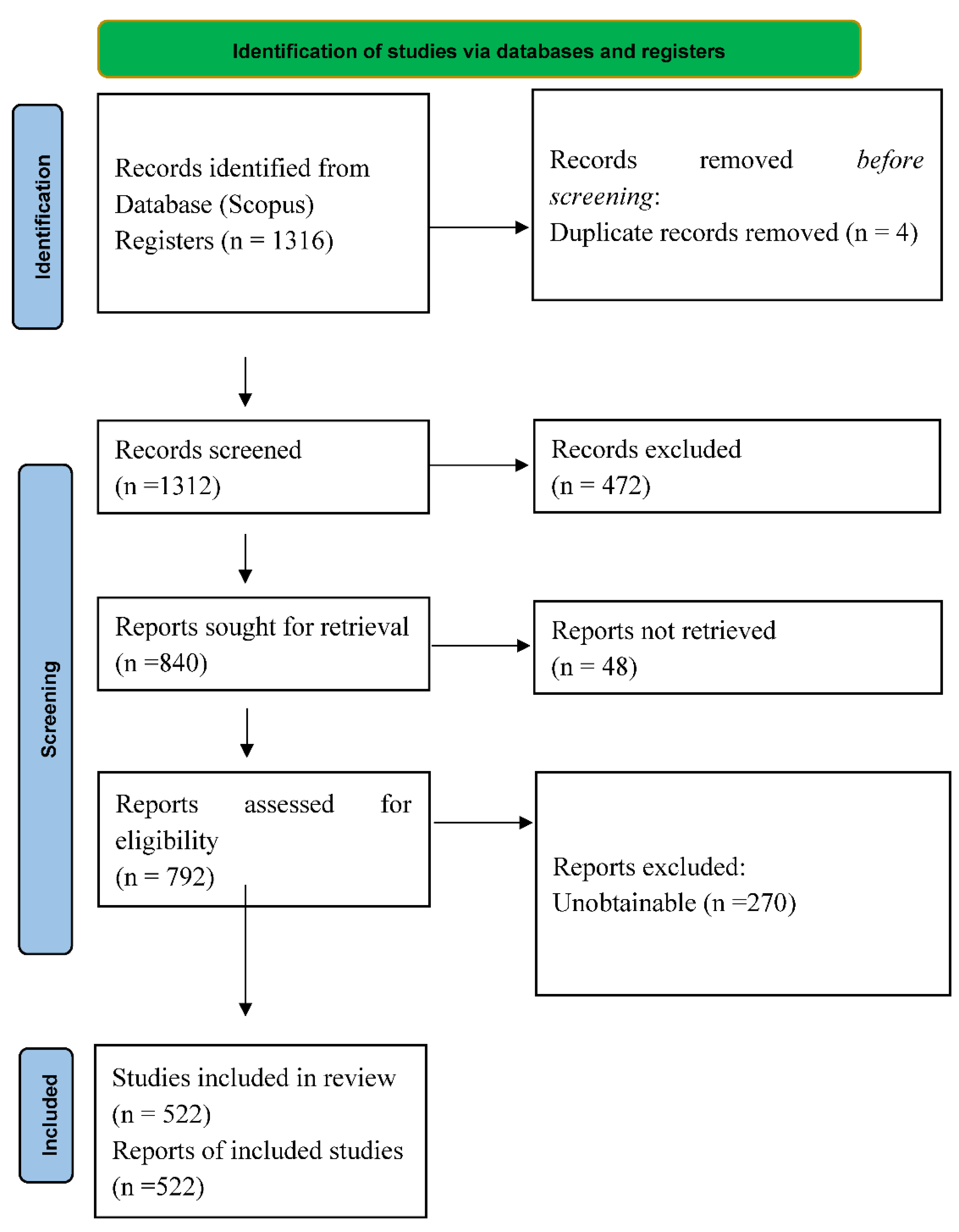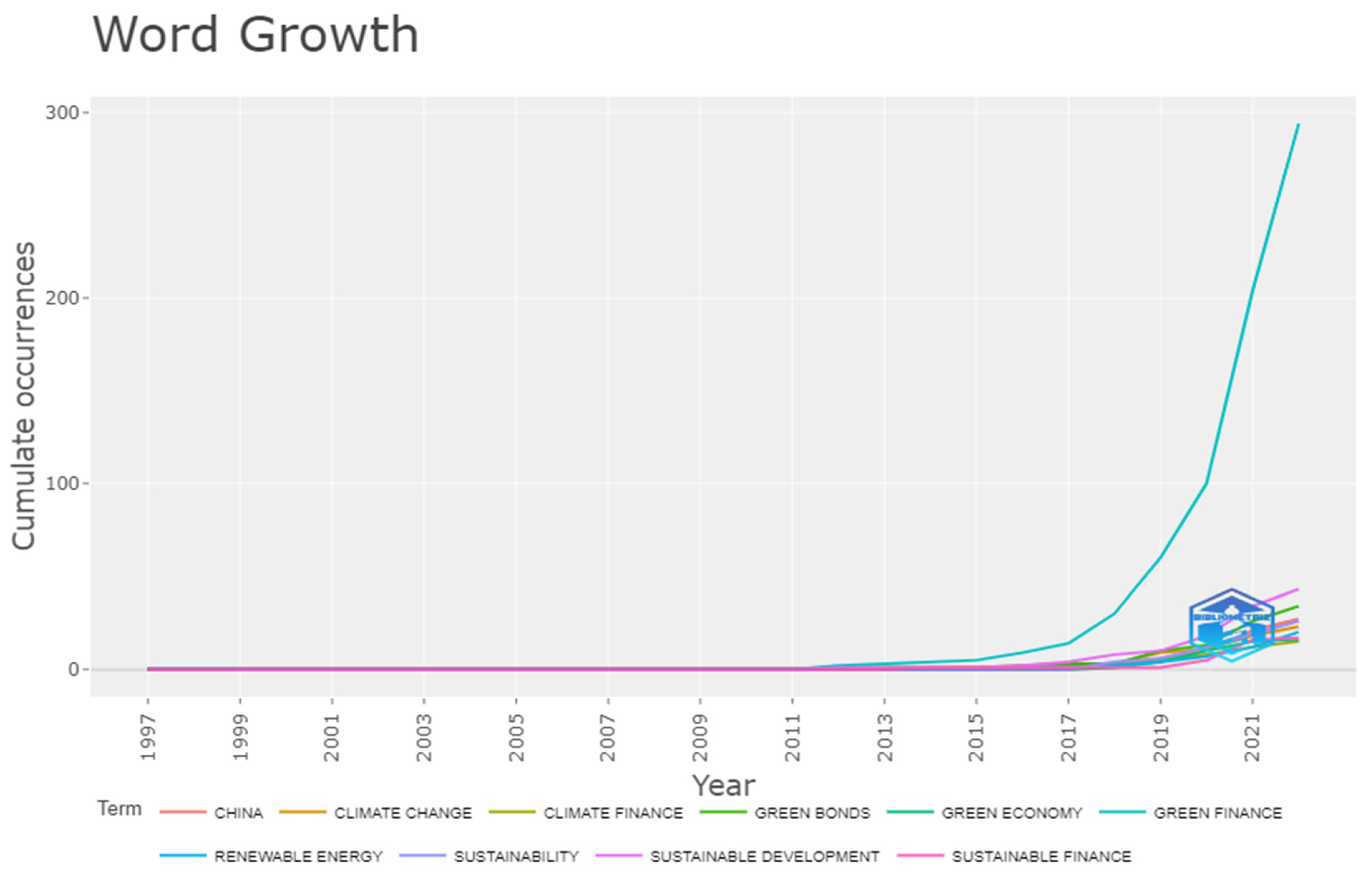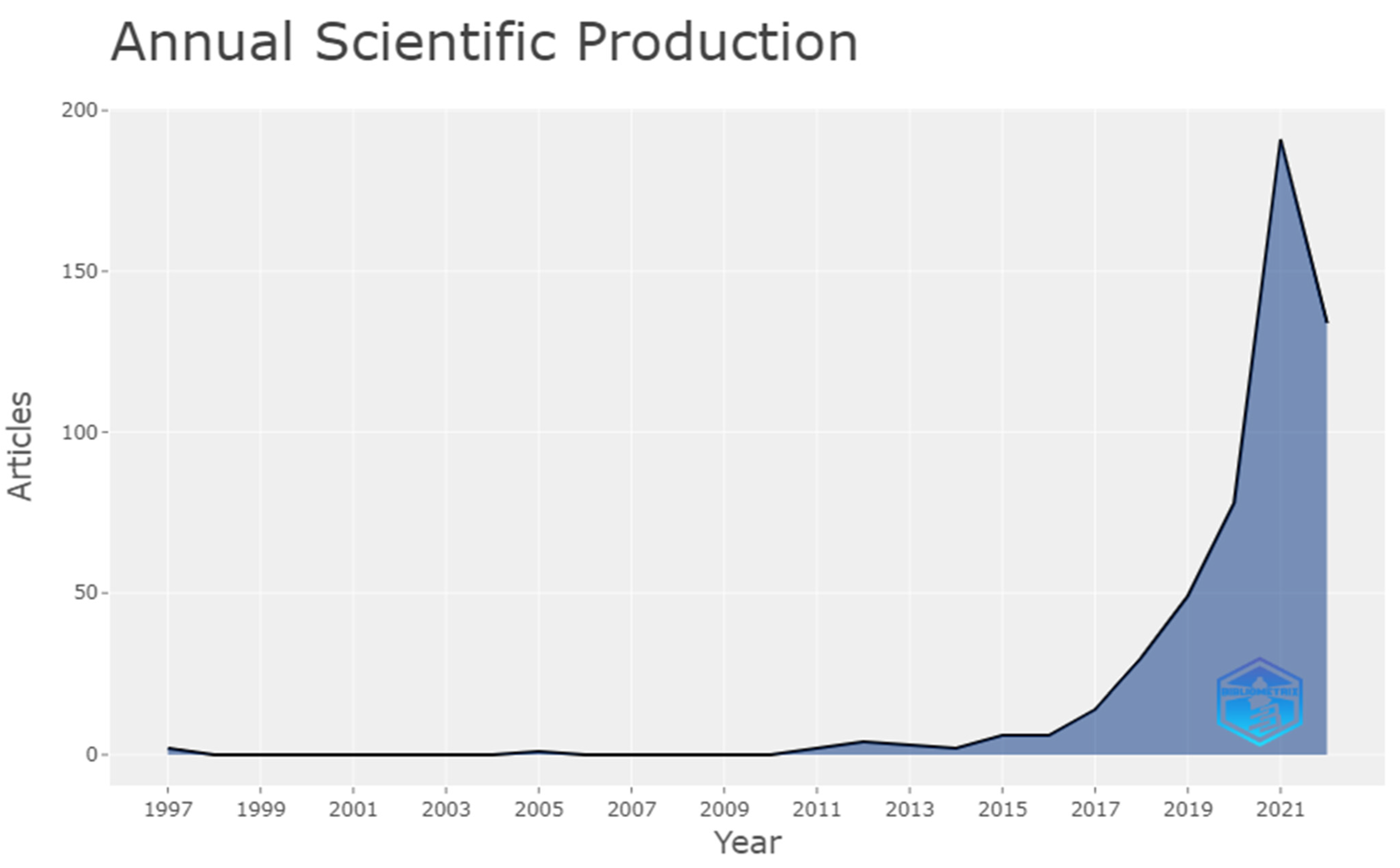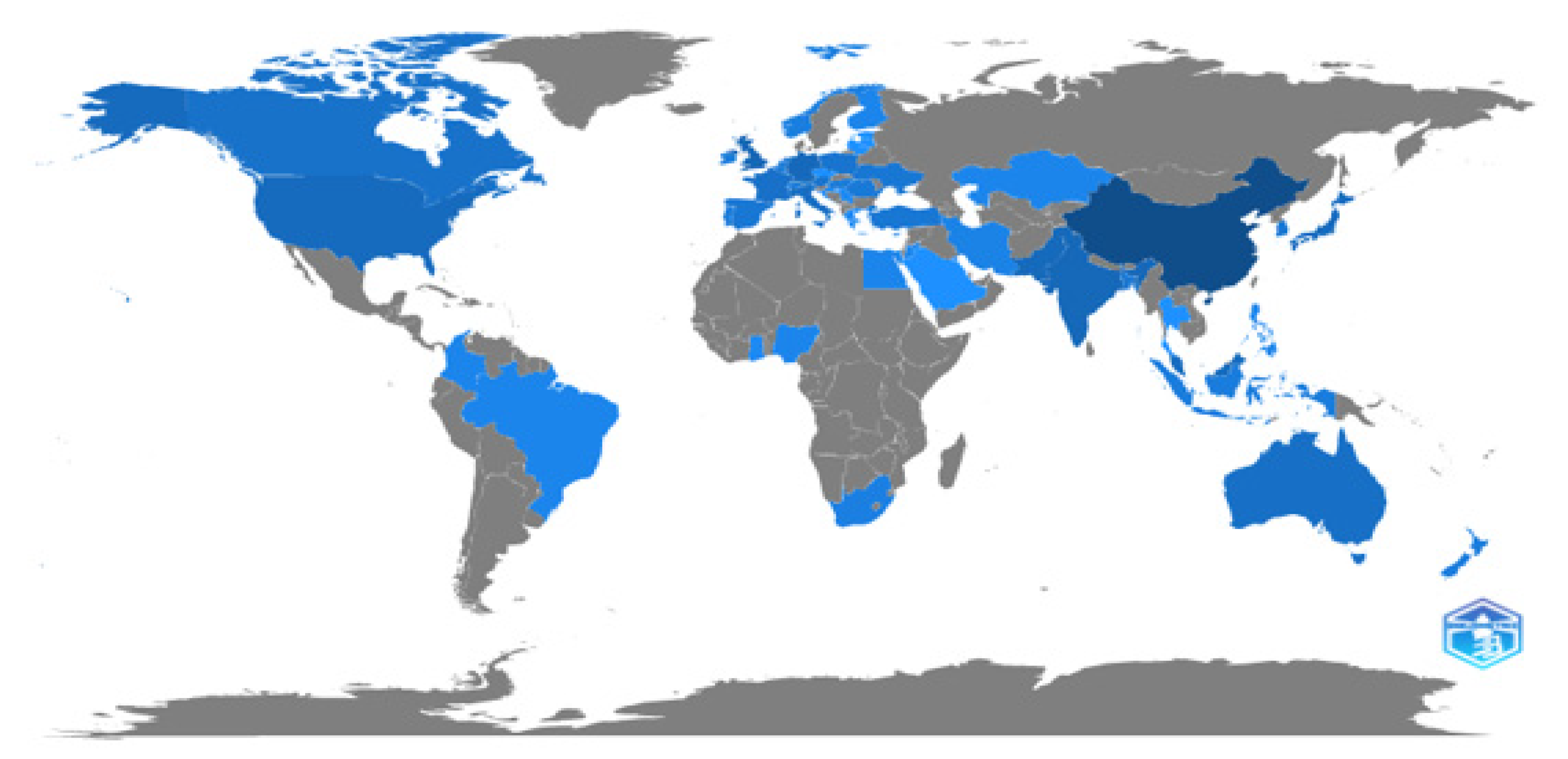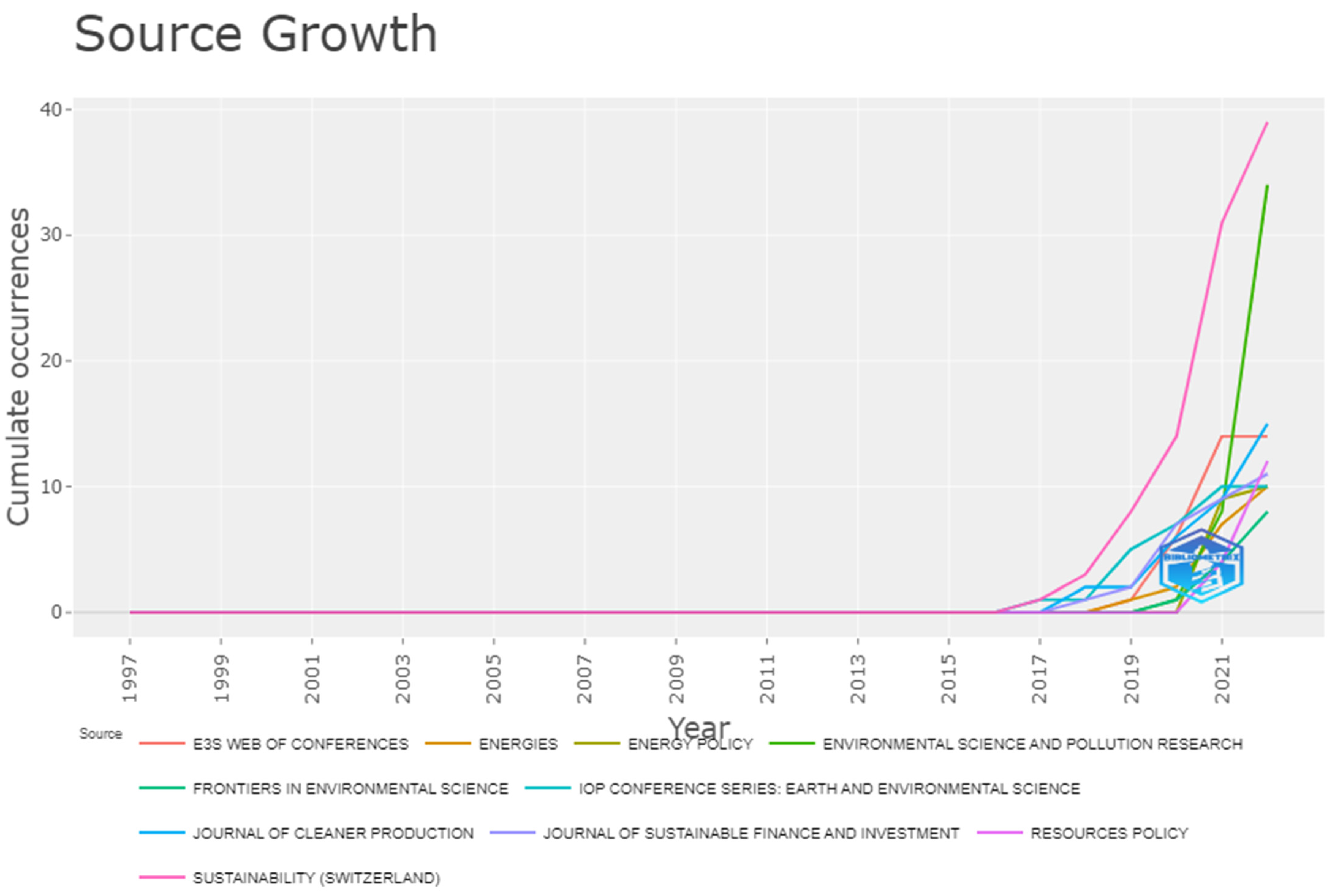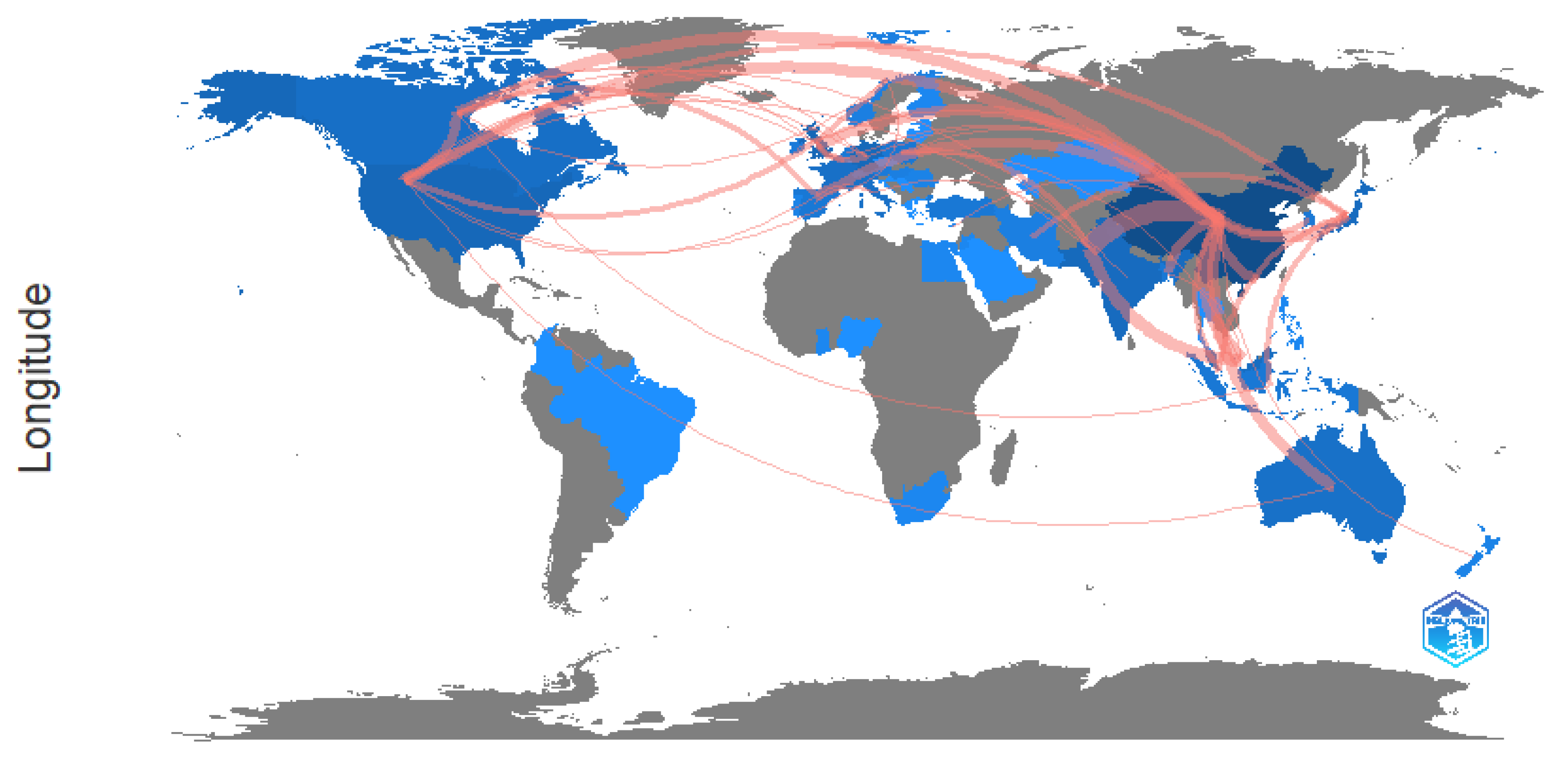1. Introduction
Since the 19th century, human activities have been the main driver of climate change, primarily due to burning fossil fuels, such as coal, oil, and gas. Burning fossil fuels generates greenhouse gas emissions that lead to raising temperatures [
1]. As a result, the Earth is now about 1.1 °C warmer than it was in the 19th century. The last decade (2011–2020) was the warmest on record [
2]. In a series of UN reports, thousands of scientists and government reviewers agreed that limiting global temperature rise to no more than 1.5 °C would help the world to avoid the worst climate impacts and maintain a livable climate [
3]. One of the strategies adopted to mitigate the impact of climate change is enhancing the level of green growth across the globe. Green growth is a term to describe a path of economic growth that is environmentally, socially, and economically sustainable [
4]. As such, green growth is closely related to the concepts of low-carbon or sustainable development [
5,
6]. The investment in green energy is quite imperative to mitigate climate change impacts [
7,
8,
9]. Particularly, investment in new renewable energy production capacity. Furthermore, different countries used different strategies to mitigate the impact of climate change. As evidence, Brazil has long supported the development of an industrial biofuel sector. China has subsidized R&D and industrial production of photovoltaic (PV) panels. Morocco is investing public funds in the production of concentrated solar power and intends to sell renewable energy to Europe [
10]. All of these activities require having a cleaner environment and mitigating climate change effects [
11].
In recent years, in order to overcome the environmental issues, de-carbonizing the economy found a nonalternative strategy [
12]. In doing so, several new methods of financing projects have emerged. Those financing methods are green bonds [
13], green credit [
14], climate finance [
15], carbon finance [
16], sustainable finance [
17], green banks [
18], and so on. The scope and content of financing methods are different; however, they are all similar in terms of objective, as all of them introduced to finance those green projects [
19]. These financing methods are collectively known as green finance. Green finance is a financing method that prioritizes green projects that are helpful in mitigating the impact of climate changes [
11]. However, whether green financing is effective in addressing current global environmental issues remains to be seen, since the green investment gap was discovered to be very large [
20].
According to a recent 2021 report published by United Nations Environment Programme [
21], the current investments in green projects amount to USD 133 billion, most of which comes from public sources, and found not enough to achieve the objective of sustainable development. The report suggests that it needs to close a USD 4.1 trillion financing gap by 2050. The study calls for green investments to triple by 2030 and to increase four-fold by 2050 from the current level. Furthermore, the study highlights the need for there to be a significant increase in private sector investment in green projects. A major concern in the transition to low-carbon energy provision, therefore, is how to obtain sufficient finance to fill the required green investment.
Among many arguments on factors currently preventing economic resources from flowing in larger amounts to green investments, the initial and critical factor is the nature of green investments regarding risk and returns trade-off. In this case, the perception of risks related to technology evolution and market development is the concern of green investors [
19]. The consequence creates low investment levels in the economy and prevents a lack of confidence among private investors [
22,
23]. Secondly, banks consider most green investment projects to be risky; as a result, they are reluctant to finance them [
10]. As a result, a large green finance gap is observed. Hence, there is a big call for all stakeholders to look for new channels of financing in this sector to fill the financing gap for such projects [
24]. Regarding the issue, the most pioneering study was first conducted in 1997 by [
25] to show the increasing collaboration of nongovernmental organizations’ partnership with the public and for-profit sectors in terms of environmental finance. The finding of the study implies that Global-North-based NGOs are the organizations that noticed environmental finance requirement, and calls all stakeholders, both government and nongovernment organizations, to enhance such capital. Despite a big call on the issue, the green financing gap is still observed across the world, and an amount of USD 4.1 trillion is required to close the financing gap as of 2050 [
21]. Having this in mind, many studies are conducted across the world to investigate the way forward to fill the finance gap. However, the practical evidence shows that the level of the green finance gap is increasing every year. Previously conducted studies highlight different reasons for the green finance gap, and one of the leading factors is lack of equal attention among countries across the globe to mitigate climate change [
26].
As a result, the current study attempts to review previously conducted studies and contributions made across the world by specific continents, countries, affiliations, and authors in both Global North and Global South countries by using a bibliometric approach analysis. In doing so, the study is interested to see how diffusion between the Global North and Global South networked for collaboration in producing green-finance-related scientific publications.
The countries are categorized based on the Organization for Economic Cooperation and Development (OECD) Development Assistance Committee’s list of countries eligible for Official Development Assistance [
27]. The concept of Global North and Global South (or North–South divide in a global context) is used to describe a grouping of countries along with socio-economic and political characteristics. The Global South is a term often used to identify the regions of Latin America, Asia, Africa, and Oceania. It is one of a family of terms, including “Third World” and “Periphery”, that denote regions outside Europe and North America, mostly (though not all) low-income and often politically or culturally marginalized countries on one side of the so-called divide, the other side being the countries of the Global North (often equated with developed countries).
The first scientific study was published by an author [
25] affiliated with the United States (Global North) in 1997; since then, many countries in the Global North have contributed more research and development of products that are highly related to environmental issues. However, following the Paris Agreement, it appears that the position has shifted to the Global South, as China is investing profoundly in environmental research and development [
10]. More specifically, among the top 10 countries leading in contributing scientific production to green finance, aggregate developing countries, such as China, Pakistan, India, and Malaysia, contributed twice that of developed countries (United Kingdom, Germany, Japan, United States, Italy, and Australia). Nonetheless, no scientific study has been conducted to determine which parts of the world pay more attention to environmental issues. This rationale motivated the researchers to conduct this study. The main contribution of this study is to provide empirical literature to existing studies on green finance that indicate which global region is highly focused on the issue of environmental finance. This study has an impact in assisting future studies to consider the status of each country in terms of green finance mobilization and capital contribution. The following
Section 2 of the study discusses the methodological approach followed in this specific review.
Section 3 discusses the overall result and interpretation using a bibliometric approach. Finally, the last section (
Section 4) highlights the discussion of the result and provides future research suggestions.
2. Methodology
The primary goal of this study was to evaluate previous studies on green finance research topics and to identify keywords associated with green finance, forming a network. Previously, systematic review research was developed with the major group, and only a few studies used evaluative and relational bibliometric studies. The development of a bibliometric approach differs from the traditional systematic literature review [
28]. It is the best method for conducting research that originates knowledge in the library and science [
29]. Bibliometric science is used to analyze all documents dealing with green finance, such as green bonds [
13], green credit [
14], climate finance [
15], carbon finance [
16], sustainable finance [
17], green banks [
18], in the fields of business and economics, social sciences, environmental sciences, and other multidisciplinary fields. It allows for the creation of network analyses, which provide a clear picture of the various links between scientific studies, countries, authors, and keywords. It also determines the co-occurrence of keywords and provides an overview of the evolution of the various themes [
30].
For this specific review, we developed a search strategy to identify relevant literature on the specific study. This search strategy was mainly from the Scopus database. The rationale for using this database is that it is considered the widest and most recommended source by previous studies [
31]. It includes the top three ranked citation indices that are most acknowledged and universally cited [
32]. The term green finance is defined in different ways by many scholars; however, the scope and content of the definitions, on the other hand, are similar [
33]. Because of the breadth of the terminologies used in green finance, we have narrowed them down to green finance, carbon finance, green fund, green credit, sustainability, sustainable finance, and climate financing based on the contents of the papers and their usefulness.
Following the identification of the best-related scope of green finance that was useful for our review, we extracted the resource using keywords All = ((“green finance” or “green financing”) and (“climate” or “climate finance” or “carbon finance”) AND (“sustainability” or “sustainable finance” or “sustainable financing” or “green fund”)) from the database that was identified (Scopus). We established criteria for including and excluding articles for review in the proposed study. In doing so, those studies written in the English language are included and others excluded. Those documents presented as articles, proceeding journals, and reviews finalized are included and other types of documents and articles in the press are excluded. The selection criteria are based on the PRISMA statement [
25]. Generally, 1316 documents were discovered through Scopus; after screening those relevant studies under the scope of the review, 522 studies were acknowledged for the review. The following
Figure 1 of the study shows the methodological approach in selecting documents extracted from the database.
The analyzed documents used in this study have been extracted from Scopus with an advanced search on 1 May 2022 using the identified keywords. The inputs are the downloaded papers from Scopus. R Studio version 3.5.3 (
https://rstudio.com/products/rstudio/download/, accessed on 6 May 2022) free open-source software was used for data analysis. To conduct this specific review, the study used the Bibliometric package (
http://www.bibliometrix.org, version 3.0.1, accessed on 6 May 2022). More specifically, the Microsoft Excel spreadsheet was used to crosscheck the authors’ names, the titles of the documents, the keywords, and the abstract of the study. Zotero reference manager was used to ensure that citations and documents were properly accounted for throughout the process.
4. Discussion
In general, the study highlights the overall trends in research publication on green finance, as well as the progress required to close the green finance gap. It also provides information on the most contributing parts of the globe, continents, countries, affiliations, journals, and authors from around the world using bibliometric analysis. Collaboration among countries was specifically investigated. The geographic distribution of scientific studies collected in terms of countries that participated in producing scientific publications on green finance demonstrates that the diffusion of green finance is more common in the Global North than in the Global South. This implies that public pressure through the press could have influenced the spread of policies in the Global North, as they have more press freedom than the Global South. However, the number of scientific studies produced over time is much greater in the Global South than Global North. More specifically, at the continental level, Asia and the Pacific are playing a lion’s share in providing scientific research publications on the green-finance-related issue, whereas the Arab states are the lowest contributing continent. To this end, the Global South authors and affiliations are also leading in contributing scientific publications compared to the Global North. More specifically, among the top 10 countries leading in contributing scientific production to green finance, aggregate developing countries, such as China, Pakistan, India, and Malaysia, contributed twice that of developed countries (United Kingdom, Germany, Japan, United States, Italy, and Australia).
Even though the Global South produces a large number of scientific publications on green finance, the number of countries involved in producing the publications are low in comparison to the Global North. In this case, it is possible to understand that a high number of countries with a low frequency of publications is observed in Global North, whereas a low number of countries with high-frequency publications is observed in Global South.
It was discovered that China has the highest number of publications worldwide (
Appendix A). The European and North American continents are the next leading continent next to Asia and the Pacific. The overall result may raise the question of “why the global south is more focused than the global north on environmental issues”. To this end, despite the progress in the research areas, the financial gap for making a green investment is still found to be huge and no way to fix this gap is found [
40]. It has been argued that the credit provided by the financial sector is insufficient to achieve the green financing gap [
45]. According to the findings of earlier studies [
46], private investors are far behind in terms of financial contribution to green investment. Private capital will be required in large amounts. However, a variety of microeconomic challenges, such as internalizing environmental externalities [
47], information asymmetry [
48], issuers’ and investors’ analytical capacity [
49], and risk–return trade-offs, are some of the problems, among others. As a result, it is recommended that the government and central banks shall play an active role in attracting private investors [
46]. The co-ordination among large and small businesses in terms of loans and investment is also required to provide the required response to the green finance gap [
15].
Tax breaks and minimum cost of capital as an option to attract private investors was recommended by different scholars [
35,
37,
47,
50,
51,
52,
53,
54,
55,
56]. However, no change has been experienced yet, as the green finance gap is increasing from time to time. Based on the review result, this study recommends that future studies be conducted on how to enhance green finance for green investment that could deliberately affect green growth. At the same time, it is good to see what would be possible incentives that could initiate private investors to make green investments, and what additional green financing methods shall be introduced to fill the financing gap. The study found China as a highest contributing country to green finance scientific studies; however, this reality may be different if another approach (per capita contribution) is used to investigate the issue of green finance. Hence, we call future studies to consider this fact in investigating the issue of green finance across the world.
Finally, it is also better if the future studies take into account the status of each country in terms of green finance mobilization and capital contribution to share the specific experience of that country and lessons taken from that country. At the same time, special consideration shall be given to those Arab states and African countries that contributed less research and development to environmental issues.
